|
|
|
|
|
|
|
|
|
|
|
|
|
|
|
|
|
|
|
|
|
|
|
|
|
|
|
|
|
|
|
|
|
|
|
|
|
|
|
|
|
|
|
|
|
|
|
|
|
|
|
|
|
|
|
|
|
|
|
|
|
|
|
|
|
|
|
|
|
|
|
|
|
|
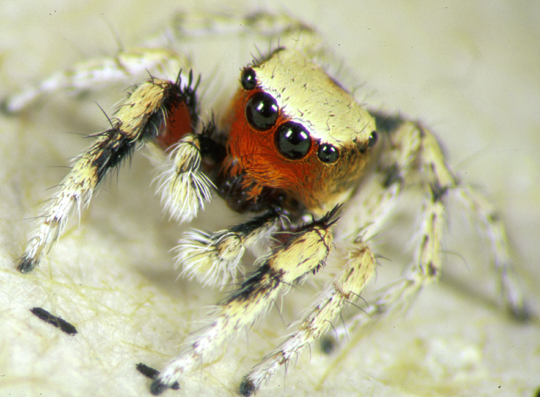 |
|
|
|
|
|
|
|
|
|
|
|
|
|
The Habronattus amicus Species Group |
|
|
|
|
|
|
|
|
|
|
This group of primarily western taxa includes three species in the region, two of which show extensive geographic variation. The species share special spines on leg I, but are otherwise heterogeneous and somewhat difficult to recognize as a group. Both H. amicus and H. ustulatus are ground-dwellers in structurally simple microhabitats, ranging from sea level to over 3000 meters (e.g., dunes, desert washes, alpine fields). H. ustulatus shows signs of substrate matching, with extensive variation across populations in dorsal coloration. H. signatus has a very different natural history, being found only on vegetation in the southern Mojave and lower Colorado deserts. |
|
|
|
|
|
|
|
|
|
|
|
|
|
|
|
|
|
|
|
|
|
|
|
|
|
|
|
|
|
|
|
|
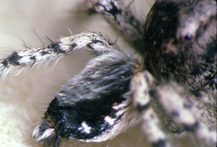 |
|
|
|
|
|
|
|
|
|
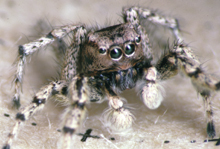 |
|
|
|
|
|
|
|
|
|
|
|
|
|
|
|
|
|
|
H. amicus -Monitor Pass., Alpine Co., CA. **Note abdominal "hair patch". |
|
|
|
|
|
|
|
|
|
|
|
|
|
H. amicus -Monitor Pass.,
Alpine Co., CA |
|
|
|
|
|
|
|
|
|
|
|
|
|
|
|
|
|
|
|
|
|
|
|
|
H. amicus - Another geographically variable Habronattus species. In California, Griswold cites records from several Pacific beaches north from Los Angeles county, and from high-elevation sites in the Sierra Nevada and Cascade mountains. One of the characters which varies across H. amicus populations is the color and development of a "hair patch" on the abdomen (see above), but the character variation is not strictly concordant with geography.
|
|
|
|
|
|
|
|
|
|
|
|
|
|
|
|
|
|
|
|
|
|
|
|
|
|
|
|
|
|
|
|
|
|
|
|
|
|
|
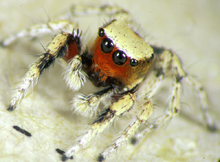 |
|
|
|
|
|
|
|
|
|
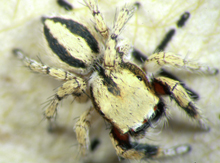 |
|
|
|
|
|
|
|
|
|
|
|
|
|
|
|
|
|
|
|
|
|
|
H. signatus -near Carricitos, B.C.N. |
|
|
|
|
|
|
|
|
|
|
|
|
|
|
|
|
|
|
|
|
H. signatus - An endemic to the southern Mojave and lower Colorado deserts, including populations on northern Gulf islands. H. signatus has only been collected from low desert scrubs (e.g., Hymenoclea, Ambrosia, etc.). The abdominal markings are unique in the species group, but the face and first leg are very similar to certain Baja populations of H. ustulatus. Curiously, H. signatus appears to have a parapatric distribution with H. ustulatus, although the two species are very different ecologically.
|
|
|
|
|
|
|
|
|
|
|
|
|
|
|
|
|
|
|
|
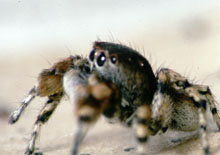 |
|
|
|
|
|
|
|
|
|
|
|
|
|
|
|
|
|
|
|
|
|
|
|
|
|
|
|
|
|
|
|
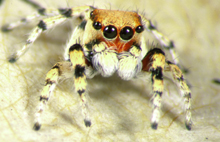 |
|
|
|
|
|
|
|
|
|
H. ustulatus -El Berrendo Cyn., B.C.N. |
|
|
|
|
|
|
|
|
|
|
|
H. ustulatus - Elsinore Mtns.,
Riverside Co., CA |
|
|
|
|
|
|
|
|
|
|
|
|
|
|
|
|
|
|
|
|
|
|
|
|
|
|
|
|
|
|
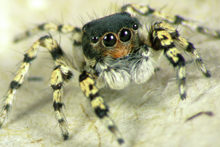 |
|
|
|
|
|
|
|
|
|
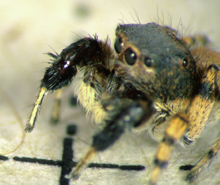 |
|
|
|
|
|
|
|
|
|
|
|
|
|
|
|
|
|
|
|
|
|
|
|
|
H. ustulatus - In-Ko-Pah Mtns.,
San Diego Co., CA |
|
|
|
|
|
|
|
|
|
|
|
|
|
H. ustulatus -Pine Valley,
San Diego Co., CA |
|
|
|
|
|
|
|
|
|
|
|
|
|
|
|
|
|
|
|
|
|
|
|
|
|
|
|
 |
|
|
|
|
|
|
|
|
|
|
|
|
|
|
|
|
|
|
|
|
|
|
|
|
|
|
|
|
|
|
|
|
|
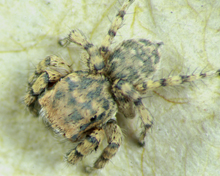 |
|
|
|
|
|
|
|
|
H. ustulatus - A wonderful little Habronattus, distributed throughout much of California and Baja in "structurally simple" habitats. Shows remarkable variation from population to population in several characteristics, the most prominent of which is dorsal coloration. Much more work is needed in the region (particularly California) to detail the fine-scale diversity of different H. ustulatus "forms". |
|
|
|
|
|
|
|
|
|
|
|
|
|
|
|
|
|
|
H. ustulatus -near Mulege., B.C.S. |
|
|
|









